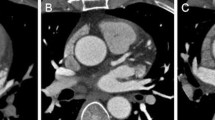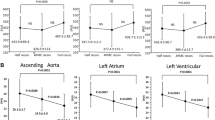Abstract
Objectives
To evaluate the feasibility of free-breathing coronary computed tomography angiography (CCTA) in adults using with a 320-detector multidetector CT (MDCT).
Methods
In 74 patients who underwent CCTA, 37 CCTA examinations were performed during free-breathing, and the remaining 37 CCTA examinations were produced with the standard breath-holding method. The quality scores for 16 segments of all coronary arteries were analysed and defined as: 1 (excellent), 2 (good), and 3 (poor). The signal-to-noise ratio (SNR), contrast-to-noise ratio (CNR), and effective radiation dose of each image were compared between the two methods.
Results
No significant differences were observed in the quality scores between the breath-holding and free-breathing methods (1.10 ± 0.31 vs. 1.12 ± 0.33; P = 0.443). The SNR and CNR were not significantly different between the two methods. The overall mean effective radiation dose revealed no significant difference between the two methods (P = 0.585).
Conclusions
Free-breathing CCTA using 320-detector MDCT showed no significant difference in image quality compared with standard breath-holding CCTA. For patients with difficulties of breath-holding or non-negligible apnoea-related heart rate variability, free-breathing CCTA can be an alternative solution for coronary artery evaluation.
Key Points
• Cardiac CT is becoming widely used and some patients are inevitably breathless.
• Multidetector CT (e.g. 320) offers new opportunities for the breathless patient.
• Free breathing images yielded similar image quality to those obtained using breath-holding.
• However, a possibility of higher radiation dose precludes its routine application.




Similar content being viewed by others
References
Hoffmann U, Nagurney JT, Moselewski F et al (2006) Coronary multidetector computed tomography in the assessment of patients with acute chest pain. Circulation 114:2251–2260
Achenbach S, Ropers D, Kuettner A et al (2006) Contrast-enhanced coronary artery visualization by dual-source computed tomography—initial experience. Eur J Radiol 57:331–335
Johnson TR, Nikolaou K, Wintersperger BJ et al (2007) ECG-gated 64-MDCT angiography in the differential diagnosis of acute chest pain. AJR Am J Roentgenol 188:76–82
Boussuges A, Gole Y, Blanc P (2009) Diaphragmatic motion studied by m-mode ultrasonography: methods, reproducibility, and normal values. Chest 35:391–400
Mao S, Lu B, Oudiz RJ, Bakhsheshi H, Liu SC, Budoff MJ (2000) Coronary artery motion in electron beam tomography. J Comput Assist Tomogr 24:253–258
Agatston AS, Janowitz WR, Hildner FJ, Zusmer NR, Viamonte M Jr, Detrano R (1990) Quantification of coronary artery calcium using ultrafast computed tomography. J Am Coll Cardiol 15:827–832
Husmann L, Alkadhi H, Boehm T et al (2006) Influence of cardiac hemodynamic parameters on coronary artery opacification with 64-slice computed tomography. Eur Radiol 16:1111–1116
Lembcke A, Wiese TH, Schnorr J et al (2004) Image quality of noninvasive coronary angiography using multislice spiral computed tomography and electron-beam computed tomography: intraindividual comparison in an animal model. Invest Radiol 39:357–364
Austen WG, Edwards JE, Frye RL et al (1975) A reporting system on patients evaluated for coronary artery disease. Report of the Ad Hoc Committee for Grading of Coronary Artery Disease, Council on Cardiovascular Surgery, American Heart Association. Circulation 51:5–40
Christner JA, Kofler JM, McCollough CH (2010) Estimating effective dose for CT using dose-length product compared with using organ doses: consequences of adopting International Commission on Radiological Protection publication 103 or dual-energy scanning. AJR Am J Roentgenol 194:881–889
Goo HW, Park IS, Ko JK et al (2005) Visibility of the origin and proximal course of coronary arteries on non-ECG-gated heart CT in patients with congenital heart disease. Pediatr Radiol 35:792–798
Tsai IC, Lee T, Chen MC et al (2007) Visualization of neonatal coronary arteries on multidetector row CT: ECG-gated versus non-ECG-gated technique. Pediatr Radiol 37:818–825
Goo HW, Yang DH (2010) Coronary artery visibility in free-breathing young children with congenital heart disease on cardiac 64-slice CT: dual-source ECG-triggered sequential scan vs. single-source non-ECG-synchronized spiral scan. Pediatr Radiol 40:1670–1680
Weigold WG (2006) Coronary CT angiography: insights into patient preparation and scanning. Tech Vasc Interv Radiol 9:205–209
Husmann L, Herzog BA, Pazhenkottil AP et al (2011) Lowering heart rate with an optimised breathing protocol for prospectively ECG-triggered CT coronary angiography. Br J Radiol 84:790–795
Rybicki FJ, Otero HJ, Steigner ML et al (2008) Initial evaluation of coronary images from 320-detector row computed tomography. Int J Cardiovasc Imaging 24:535–546
Xu L, Yang L, Fan Z, Yu W, Lv B, Zhang Z (2011) Diagnostic performance of 320-detector CT coronary angiography in patients with atrial fibrillation: preliminary results. Eur Radiol 21:936–943
Li Y, Fan Z, Xu L, et al. (2012) Prospective ECG-gated 320-row CT angiography of the whole aorta and coronary arteries. Eur Radiol. Jun 4. [Epub ahead of print]
Schnapauff D, Teige F, Hamm B, Dewey M (2009) Comparison between the image quality of multisegment and halfscan reconstructions of non-invasive CT coronary angiography. Br J Radiol 82:969–975
Dewey M, Teige F, Laule M, Hamm B (2007) Influence of heart rate on diagnostic accuracy and image quality of 16-slice CT coronary angiography: comparison of multisegment and halfscan reconstruction approaches. Eur Radiol 17:2829–2837
Acknowledgments
This study was supported by research funds from Dong-A University.
Author information
Authors and Affiliations
Corresponding author
Rights and permissions
About this article
Cite this article
Kang, EJ., Lee, J., Lee, KN. et al. An initial randomised study assessing free-breathing CCTA using 320-detector CT. Eur Radiol 23, 1199–1209 (2013). https://doi.org/10.1007/s00330-012-2703-z
Received:
Revised:
Accepted:
Published:
Issue Date:
DOI: https://doi.org/10.1007/s00330-012-2703-z




